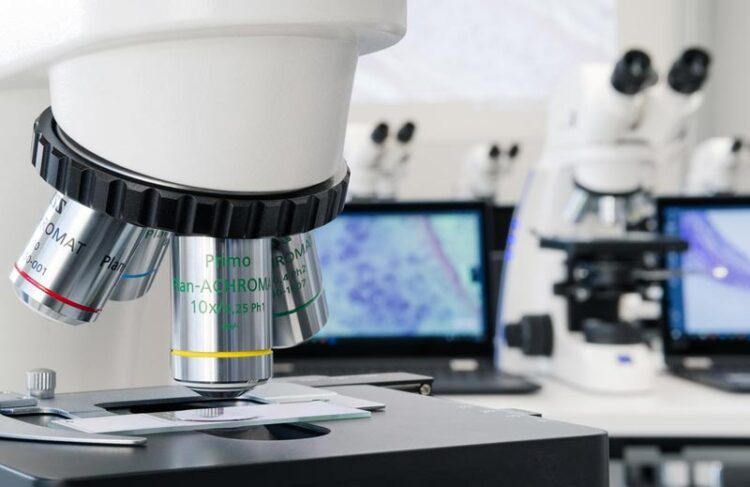Disturbed skin flora increases the risk of radiodermatitis

© Universität Augsburg
Bacterial composition of the skin plays a role in determining how well cancer patients tolerate radiotherapy.
Many cancer patients develop severe dermatitis during radiotherapy. Which factors increase the risk of such radiodermatitis has only been partially understood up until now. A pilot study at the University of Augsburg, the Technical University of Munich (TUM), and Helmholtz Munich now points to the important role played by skin bacteria. Breast cancer patients whose skin microbiome was severely disturbed all developed severe dermatitis during radiotherapy. The results give hope of a test that is able to provide early identification of at-risk groups. The results have been published in the renowned medical journal JAMA Oncology.
Radiotherapy is one of the most important weapons in the fight against cancer. It destroys tumour cells through high-energy radioactive radiation. Nevertheless, some patients tolerate treatment worse than others, with some patients developing severe skin inflammation – radiodermatitis – at the irradiated site. Until now, it was largely unclear why this only affected some of those treated.
The new study now sheds some light on this, with the skin flora of the breast decisive in determining whether radiodermatitis occurs during the course of treatment. “The skin microbiome consists of hundreds of different kinds of microorganisms,” explains Claudia Hülpüsch, head of functional microbiomics at the Chair for Environmental Medicine at the University of Augsburg. “Some of them, the so-called commensal bacteria, are present in healthy people in a relative higher number and are part of the skin barrier. They act as natural protection, preventing the proliferation of harmful bacteria or fungi, for example.”
Skin flora as a marker for increased risk of dermatitis
Together with her project partner Dr Kai J. Borm from the University Hospital rechts der Isar at TUM, Hülpüsch examined 20 women with breast cancer. All patients received ra-diotherapy for a period of seven weeks. Before the first appointment and then each week thereafter the researchers took a skin swab from each patient – one from the breast treat-ed with radiotherapy and one from the untreated breast. From the swabs, they were able to determine the number and composition of microorganisms.
“Through the analysis we determined that before beginning the radiotherapy four women had an unusual skin microbiome,” explains Prof. Dr Avidan Neumann from the Chair for En-vironmental Medicine at the University of Augsburg and researcher at Helmholtz Munich, who also participated in the study. “With these women, commensal bacteria were un-derrepresented. This was the case for the healthy as well as for the diseased breast. Inter-estingly, each of these four patients developed severe radiodermatitis during the course of radiotherapy.” By contrast, the other 16 patients only developed mild or moderate skin damage during radiotherapy. In the first few weeks of therapy in the four patients with underrepresented commensal bacteria, the number of bacteria developed significantly before the development of visibly severe symptoms and then decreased again near the end of therapy. With the other patients, the bacteria remained largely unchanged. This leads to the suggestion that the bacteria play a causal role in the development of radi-odermatitis.
Skin disinfection reduces the likelihood of dermatitis
“The composition of skin bacteria before radiotherapy appears to indicate which women have a particularly high risk of developing radiodermatitis,” says Borm. “This helps in un-derstanding this side-effect, enabling us to take targeted preventative measures to make radiotherapy more tolerable for patients in future.” Initial studies show that a thorough disinfection of the skin surface reduces the likelihood of subsequent inflammation. “We are also curious to find out if our results can be transferred to patients with other cancer types, such as those in the throat, nose, and ear, or with sarcomas, as these patients have a particularly high risk of severe radiodermatitis.”
Prof. Dr Claudia Traidl-Hoffmann, a dermatologist and director of the Chair for Environ-mental Medicine, sees great potential in the results and is already thinking about next steps. “We will now carry out larger studies with more patients with other tumours in or-der to verify the results. The goal is to be able to predict and prevent dermatitis, and this study has paved the way for this.”
Wissenschaftliche Ansprechpartner:
Prof. Dr. med. Claudia Traidl-Hoffmann
Director Chair for Environmental Medicine University of Augsburg
Director Institute für Environmental Medicine Helmholtz Munich
Telephone: +49 821 598 6424
Claudia.Traidl-Hoffmann@uni-a.de
Originalpublikation:
Claudia Hülpüsch et al.: Association of Skin Microbiome Dynamics With Radiodermatitis in Patients With Breast Cancer; JAMA Oncology
DOI:10.1001/jamaoncol.2023.6533
https://jamanetwork.com/journals/jamaoncology/fullarticle/2814528
Media Contact
All latest news from the category: Health and Medicine
This subject area encompasses research and studies in the field of human medicine.
Among the wide-ranging list of topics covered here are anesthesiology, anatomy, surgery, human genetics, hygiene and environmental medicine, internal medicine, neurology, pharmacology, physiology, urology and dental medicine.
Newest articles

NASA: Mystery of life’s handedness deepens
The mystery of why life uses molecules with specific orientations has deepened with a NASA-funded discovery that RNA — a key molecule thought to have potentially held the instructions for…

What are the effects of historic lithium mining on water quality?
Study reveals low levels of common contaminants but high levels of other elements in waters associated with an abandoned lithium mine. Lithium ore and mining waste from a historic lithium…

Quantum-inspired design boosts efficiency of heat-to-electricity conversion
Rice engineers take unconventional route to improving thermophotovoltaic systems. Researchers at Rice University have found a new way to improve a key element of thermophotovoltaic (TPV) systems, which convert heat…



